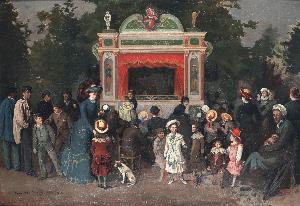Goseda Yoshimatsu
五姓田義松;Goseda Yoshimatsu
Place: Edo
Born: 1855
Death: 1915
Biography:
Goseda Yoshimatsu was a prominent Japanese painter who lived from 1855 to 1915. Born in Edo, he was the second son of Goseda Hōriū, a Yōga painter. From a young age, Yoshimatsu was exposed to Western-style painting and went on to become one of the most important painters of his time.
Early Career
In 1865, Goseda Yoshimatsu became a pupil of Charles Wirgman, a British painter who had come to Japan to teach Western-style painting. This marked the beginning of Yoshimatsu's journey as a painter. In 1874, he was employed at the Imperial Japanese Army Academy as a picture teacher, where he taught painting to army officers.
Training and Influences
Yoshimatsu's training included studying under Antonio Fontanesi, an Italian painter who had come to Japan to teach Western-style painting. In 1876, Yoshimatsu entered the Engineering Technology Art School, where he honed his skills as a painter. He was also influenced by Léon Bonnat, a French painter whom he met during his time in France.
Notable Works and Achievements
In 1877, Goseda Yoshimatsu won the Hōmon Prize at the first domestic industrial exposition with his painting Abekawa Fuji Zu. This marked a significant milestone in his career. In 1880, he traveled to France and became a pupil of Léon Bonnat. His work was accepted for the Salon, a famous exhibition, in 1882, making him the first Japanese painter to achieve this feat.
Later Life and Legacy
After returning to Japan in 1889, Goseda Yoshimatsu participated in the establishment of the Meiji Art Society. He also participated in the First Sino-Japanese War. Yoshimatsu's legacy as a painter can be seen in his notable works, which are now housed in various museums, including the Chiba Prefectural Museum of Art. For more information on Yoshimatsu's life and works, visit The Nihonga Art Movement or Goseda Yoshimatsu's Wikipedia page.
- Notable works: Abekawa Fuji Zu, Design for a fan by Taki Katei
- Museums: Chiba Prefectural Museum of Art, National Museums Liverpool
- Influences: Charles Wirgman, Antonio Fontanesi, Léon Bonnat
's life and works serve as an important part of Japanese art history, showcasing the country's transition from traditional to Western-style painting. His legacy can be seen in his notable works and the many museums that house them, including Taki Katei's Design for a fan at the National Museums Liverpool.

